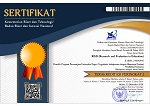Developing an instrument of national examination of equivalency education Package C of mathematics subject
DOI:
https://doi.org/10.21831/reid.v4i1.15556Keywords:
instrument, evaluation, national examination, equality educationAbstract
The national examination of equivalency education is a competency test to equalize non-formal education with formal education. Departing from the importance of the quality and expectations of the national examination of equivalency education package C mathematics subjects and because the results are inseparable from the implementation process, developing an evaluation instrument to assess the implementation of the national examination of equivalency education package C mathematics subjects is important. The purpose of this study is to develop a suitable instrument for conducting an evaluation of the national examination implementation of the equivalency education package C mathematics subject. The respondents in this research are package C test takers in Bantul Regency, Yogyakarta. The data were analyzed by using SPSS 20.0 and Lisrel 8.54. The result of the analysis shows (1) based on the data obtained from respondents of try-out, the developed instrument is valid, reliable and qualified as a fit model; (2) components in the instrument of test takers is learning time, socialization, test materials, and test venue; and (3) the instrument have the validity value of > 0.40 and reliability coefficient of > 0.70.
References
Adow, I. M., Alio, A. A., & Thinguri, R. (2015). An assessment of the management of KCSE examination and its influence on irregularities among students: A case of secondary schools in Mandera County, Kenya. Journal of Education and Practice, 6(28), 15–22.
Azwar, S. (2015). Reliabilitas dan validitas (4th ed.). Yogyakarta: Pustaka Pelajar.
Cattell, R. B. (1978). The scientific use of factor analysis in behavioral and life sciences. New York, NY: Plenum Press.
Child, D. (2006). The essentials of factor analysis (erd ed.). New York, NY: Continuum.
Christiansen, B., Howson, A. G., & Otte, M. (Eds.). (1986). Perspectives on mathematics education. Dordrecht: Springer Netherlands.
Costello, A. B., & Osborne, J. W. (2005). Best practices in exploratory factor analysis: Four recommendations for getting the most from your analysis. Practical Assessment, Research & Evaluation, 10(7), 1–9. Retrieved from http://www.statsoft.com/textbook/
Ghozali, I. (2005). Structural equation modeling: Teori, konsep, dan aplikasi dengan program Lisrel 8.80. Semarang: Badan Penerbit Universitas Diponegoro.
Government Regulation No. 19 of 2005, on National Education Standard (2005). Republic of Indonesia.
Hatfield, M. M., Edwards, N. T., Bitter, G. G., & Morrow, J. (2008). Mathematics methods for elementary and middle school teachers. Hoboken, NJ: John Wiley and Sons.
Hendryadi, & Suryani. (2014). Structural equation modeling dengan Lisrel 8.80. Jakarta: Kaukaba Dipantara.
Kahn, P., & Kyle, J. (Eds.). (2002). Effective learning and teaching in mathematics and its applications. London: Routledge.
Kartowagiran, B. (2008). Validasi dimensionalitas perangkat tes ujian akhir nasional SMP mata pelajaran matematika 2003-2006. Jurnal Penelitian Dan Evaluasi Pendidikan, 12(2), 177–195. https://doi.org/10.21831/pep.v12i2.1426
Kartowagiran, B. (2013). Evaluasi dan pengembangan kurikulum. A paper presented in Workshop Evaluasi Kurikulum STABN Raden Wijaya.
Law No. 20 of 2003 of Republic of Indonesia on National Education System (2003).
Mardapi, D. (2005). Teknik penyusunan instrumen tes dan nontes. Yogyakarta: Mitra Cendekia.
Mardapi, D. (2012). Pengukuran, penilaian, dan evaluasi pendidikan. Yogyakarta: Nuha Medika.
Mardapi, D., & Kartowagiran, B. (2009). Dampak ujian nasional. A research report. Yogyakarta: Program Pascasarjana UNY.
Mathematical Sciences Education Board of National Research Council. (1993). Measuring what counts: A conceptual guide for mathematics assessment. Washington, DC: National Academy Press.
Mudjijanti, F. (2011). Pengaruh tes masuk berdasarkan nilai ujian nasional (UN) terhadap prestasi belajar siswa (Studi kasus di SMUK St. Bonaventura Madiun). Widya Warta, 35(2), 19–31.
Raharjo, S. B. (2012). Evaluasi trend kualitas pendidikan di Indonesia. Jurnal Penelitian Dan Evaluasi Pendidikan, 16(2), 511–532. https://doi.org/10.21831/pep.v16i2.1129
Rossi, P. H., & Freeman, H. E. (1985). Evaluation: A systematic approach. Baverly Hills: Sage.
Setiadi, H. (2011). Analisis kelemahan kompetensi siswa pada tingkat kabupaten/kota berdasarkan hasil UN rendah tahun 2011 di Kabupaten Alor. A research report. Jakarta: Badan Penelitian dan Pengembangan Pusat Penilaian Pendidikan.
Sudjana, D. (2006). Evaluasi program pendidikan luar sekolah untuk pendidikan nonformal dan pengembangan sumber daya manusia. Bandung: Remaja Rosdakarya.
Tabachnick, B. G., & Fidell, L. S. (2007). Using multivariate statistics (4th ed.). Hillsdale: Erlbaum.
Weiss, C. H. (1972). Evaluation research. London: Prentice-Hall.
Worthen, B. R., & Sanders, J. R. (1981). Educational evaluation: Theory and practice. Worthington, OH: Charles A. Jones.
Yong, A. G., & Pearce, S. (2013). A beginner's guide to factor analysis: Focusing on exploratory factor analysis. Tutorials in Quantitative Methods for Psychology, 9(2), 79–94. https://doi.org/10.20982/tqmp.09.2.p079
Downloads
Published
How to Cite
Issue
Section
Citation Check
License
The authors submitting a manuscript to this journal agree that, if accepted for publication, copyright publishing of the submission shall be assigned to REID (Research and Evaluation in Education). However, even though the journal asks for a copyright transfer, the authors retain (or are granted back) significant scholarly rights.
The copyright transfer agreement form can be downloaded here: [REID Copyright Transfer Agreement Form]
The copyright form should be signed originally and sent to the Editorial Office through email to reid.ppsuny@uny.ac.id

REID (Research and Evaluation in Education) by http://journal.uny.ac.id/index.php/reid is licensed under a Creative Commons Attribution-ShareAlike 4.0 International License.







.png)





